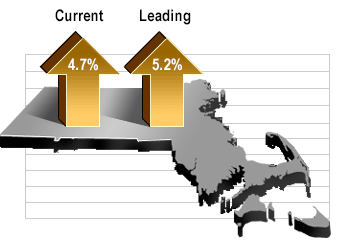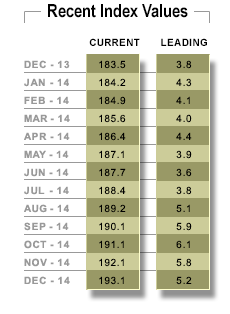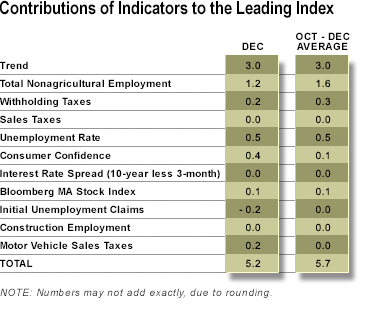State Economy Expands Robustly in Q4 2014, UMass Journal Reports
Strong job, income, and labor force growth fueling state expansion
December 2014
 Massachusetts real gross domestic product grew at an estimated annual rate of 4.7 percent in the fourth quarter of 2014 according to the MassBenchmarks Current Economic Index, released today by MassBenchmarks, the journal of the Massachusetts economy published by the UMass Donahue Institute in collaboration with the Federal Reserve Bank of Boston. U.S. real domestic gross product grew at an annual rate of 2.6 percent according to the advance estimate of the U.S. Bureau of Economic Analysis.
Massachusetts real gross domestic product grew at an estimated annual rate of 4.7 percent in the fourth quarter of 2014 according to the MassBenchmarks Current Economic Index, released today by MassBenchmarks, the journal of the Massachusetts economy published by the UMass Donahue Institute in collaboration with the Federal Reserve Bank of Boston. U.S. real domestic gross product grew at an annual rate of 2.6 percent according to the advance estimate of the U.S. Bureau of Economic Analysis.
The Massachusetts and U.S. economies finished 2014 with three successive quarters of strong growth. Based on the latest available information, we now estimate that in the third quarter of 2014, the state economy expanded at a 6.0 percent annualized rate; in the second quarter, it was 5.2 percent; and in the first quarter it declined by 2.4 percent (largely due to an extended spell of nasty weather courtesy of the polar vortex). Nationally, the US expanded at an annual rate of 5.0 percent in the third quarter; 4.6 percent in the second quarter; and negative 2.1 percent in the first quarter.
 All four components of the MassBenchmarks Current Economic Index exhibited strong growth in the second half of 2014. State payroll employment expanded at a 2.0 percent annualized rate in both the third and the fourth quarters. Employment levels in Massachusetts in the fourth quarter of 2014 were 1.7 percent higher than they were in the fourth quarter of 2013, reflecting the creation of over 60,000 net new jobs in 2014, the best performance since 2000. Nationally, employment expanded at a 2.4 percent annualized rate in the fourth quarter and 2.1 percent in the third quarter. National employment levels were 2.1 percent higher in the fourth quarter of 2014 than during the same period in 2013.
All four components of the MassBenchmarks Current Economic Index exhibited strong growth in the second half of 2014. State payroll employment expanded at a 2.0 percent annualized rate in both the third and the fourth quarters. Employment levels in Massachusetts in the fourth quarter of 2014 were 1.7 percent higher than they were in the fourth quarter of 2013, reflecting the creation of over 60,000 net new jobs in 2014, the best performance since 2000. Nationally, employment expanded at a 2.4 percent annualized rate in the fourth quarter and 2.1 percent in the third quarter. National employment levels were 2.1 percent higher in the fourth quarter of 2014 than during the same period in 2013.
The Commonwealth's unemployment rate fell from 6.0 percent in September to 5.5 percent in December. It is now 1.6 percentage points lower than it was in December of 2013. The U.S. unemployment rate fell from 5.9 percent in September to 5.6 percent in December and is now 1.1 percentage points below its December 2013 level. Massachusetts wage and salary income – as estimated from state withholding taxes – grew at a 10.7 percent annual rate in the fourth quarter following growth of 9.1 percent in the third quarter. Wage and salary income in the fourth quarter was 6.0 percent higher than the fourth quarter of 2013. State spending on items subject to the regular sales tax and motor vehicle sales tax grew at a 7.4 percent annual rate in the fourth quarter, following 1.1 percent in the third quarter. Fourth quarter spending was 5.1 percent higher than in the fourth quarter of 2013.
"The state and national economies appear to have achieved escape velocity following an extended but steady recovery from the 'Great Recession'," noted Alan Clayton-Matthews, MassBenchmarks Senior Contributing Editor and Associate Professor of Economics and Public Policy at Northeastern University, who compiles and analyzes the Current and Leading Indexes.
The results of the household survey strongly suggest there were significant improvements in the state labor market in 2014. In the fourth quarter of 2014, the state's labor force grew at a 4.5 percent annual rate while resident employment grew at a 4.7 percent annual rate. Year over year, between December 2013 and December 2014, the state's labor force grew by 83,300 while resident employment grew by 134,700. "While the household survey is subject to considerable sampling error and should be interpreted cautiously, this is the strongest year-over-year labor force growth recorded by these measures in the history of the data series going back to January 1976," Clayton-Matthews added.
Notably, while the state's unemployment rate remains high for the young and the less well-educated, it fell faster for these groups in 2014 than for the overall labor force. The annual average unemployment rate for Massachusetts residents under 25 years old fell from 15.8 percent in 2013 to 13.5 percent in 2014; for those without a high school diploma, it fell from 20.1 percent in 2013 to 14.1 percent in 2014; and for those with a high school diploma, it fell from 9.3 percent in 2013 to 6.9 percent in 2014. The state's
"U-6" unemployment rate, which includes workers who want to work full-time but can only find part-time work, and persons who want a job but have not looked recently (the so-called "marginally-attached" members of the labor force), fell from an annual average of 13.2 percent in 2013 to 11.5 percent in 2014.
The MassBenchmarks Leading Economic Index for December is 5.2 percent, and the three-month average for October through December is 5.7 percent. The leading index is a forecast of the growth in the current index over the next six months, expressed at an annual rate. Thus, it indicates that the economy is expected to grow at an annualized rate of 5.2 percent over the next six months (through June 2015), with expected first quarter growth of 5.6 percent and second quarter growth of 5.2 percent.
 The 10 indicators that comprise the leading index usually do not all move in tandem. Typically, some may indicate an expectation of faster than average growth, while at the same time others may indicate an expectation of slower than average growth. The table accounts for the contributions of each towards faster or slower growth than the trend of 3.0 percent. The index value is their sum.
The 10 indicators that comprise the leading index usually do not all move in tandem. Typically, some may indicate an expectation of faster than average growth, while at the same time others may indicate an expectation of slower than average growth. The table accounts for the contributions of each towards faster or slower growth than the trend of 3.0 percent. The index value is their sum.
In December, six indicators contributed to a forecast of above-trend growth: total nonagricultural employment, withholding taxes, the unemployment rate, consumer confidence, the Bloomberg stock index for Massachusetts, and motor vehicle sales taxes. Three indicators contributed to average-trend growth: sales taxes, the interest rate spread between 10-year and 3-month U.S. Treasury securities, and construction employment. One indicator, initial unemployment claims, contributed to below-trend growth.
In the three-month period October through December, five indicators contributed to a forecast of above-trend growth: total nonagricultural employment, withholding taxes, the unemployment rate, consumer confidence, and the Bloomberg stock index for Massachusetts. Five indicators contributed to average-trend growth: sales taxes, the interest rate spread between 10-year and 3-month U.S. Treasury securities, initial unemployment claims, construction employment, and motor vehicle sales taxes. No indicators contributed to below-trend growth.
The current and historical quarterly estimates for state domestic product growth include adjustments for changes in productivity growth. These adjustments are estimates of the quarterly deviations from trend in the growth of the ratio of output to employment and output to wage and salary income. In the fourth quarter of 2014, these adjustments subtracted 1.5 percentage points from the annual rate of growth. In the third quarter of 2014, these adjustments added 1.2 percentage points to the annual rate of growth. In the second quarter of 2014, these adjustments added 0.5 percentage points to the annual rate of growth. In the first quarter, these adjustments subtracted 7.1 percentage points from the annual rate of growth. For the forecast of state domestic product growth in the first and second quarters of this year, productivity growth is assumed to return to its trend.
Several recent months of the indices are revised each release. These revisions are a result of the statistical method used to create the index, as well as revisions in the underlying indicators.
--------
All of the indicators except interest rates refer to Massachusetts. The current index is composed of four indicators: nonagricultural employment, withholding taxes, sales taxes, and the unemployment rate. The leading index includes these four current indicators plus the other six (leading) indicators in the contributions table. All of the indicators are as of December, except for interest rates and the Bloomberg stock index for Massachusetts, which are through January 16. The MassInsight Consumer Confidence Index is released every third month. Intervening months are interpolated, and changes in the Conference Board's Consumer Confidence Index for the U.S. are used to extrapolate to the current month of the index, as needed. Series measured in current dollars or values, i.e., withholding taxes, sales taxes, the Bloomberg stock index, and motor vehicle sales taxes, are deflated by the U.S. consumer price index for all urban consumers, excluding food and energy.
For a description of the methodology used to construct these indices, see: Alan Clayton-Matthews and James H. Stock, "An application of the Stock/Watson index methodology to the Massachusetts economy," Journal of Economic and Social Measurement, vol. 25 (1998/1999), pp. 183-233.
Dr. Alan Clayton-Matthews
MassBenchmarks
Northeastern University, School of Public Policy and Urban Affairs
January 30, 2015

